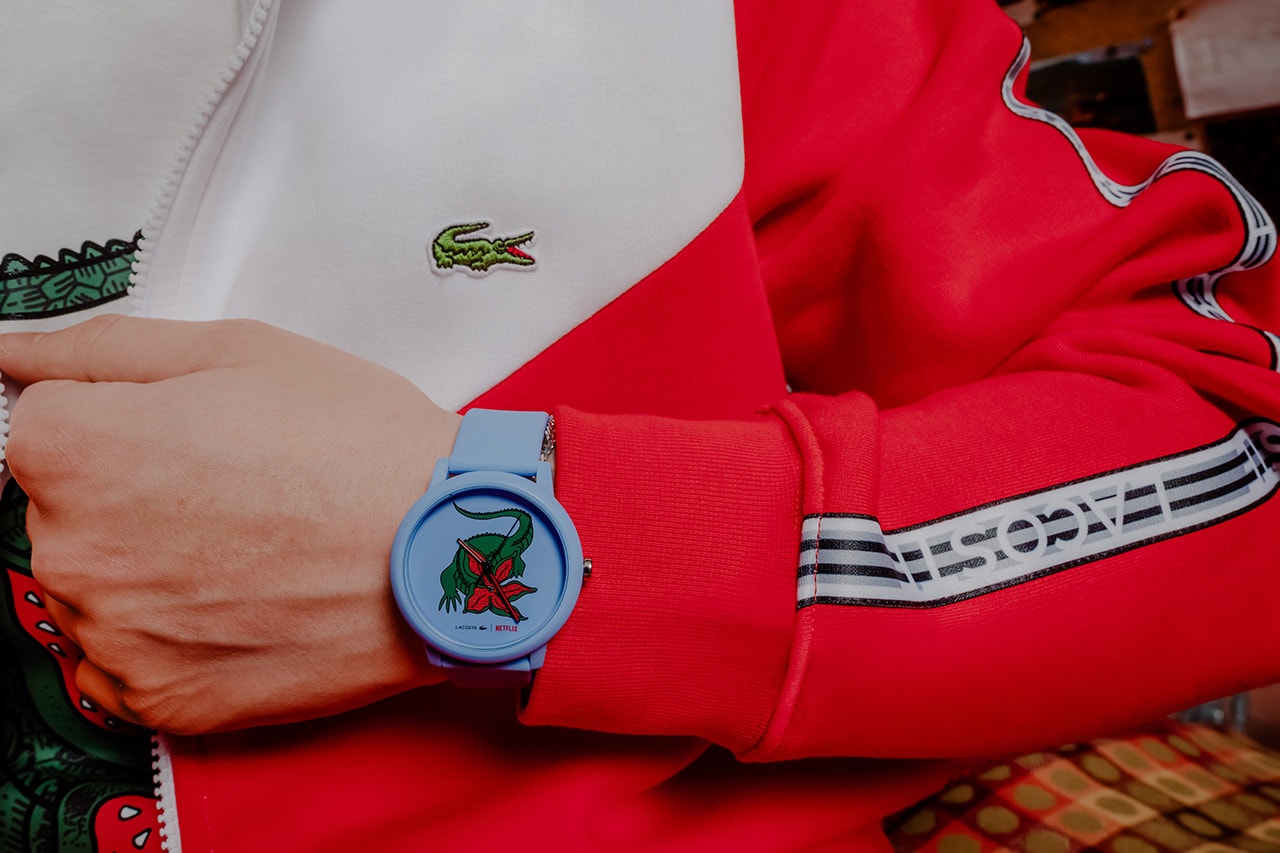

Lacoste is gearing up to launch its latest collaboration with Netflix — seeing the label recreate its most-celebrated shows for a full ready-to-wear collection.
As part of the campaign, the brand has teamed up with Hypebeast to explore two of the streaming service’s most iconic series. Enlisting cultural commentator, curator, and founder of Cold Archive Lewis James Dixon, the archivist delves into the cultural impact of Stranger Things and how references from the past continue to influence our outlook today.
As well as providing an insight into its success, Dixon highlights how the show has ushered in the revival of the ‘80s “nerd” – drawing a correlation between the once-outsider subculture and the current cultural zeitgeist – to pose the question: Have nerds won the culture war?
You can read Dixon’s complete analysis of Stranger Things’ impact below.
“The show itself is a collection of 1980s ephemera; a time capsule reinvigorating old products and memories for a new generation.”
A generation-defining pop-culture behemoth, Stranger Things has undeniably been one of the most important Netflix productions of all time. Created by twins Matt and Ross Duffer, the show masterfully blends ‘80s iconography and rich storytelling with such finesse that it’s become a cultural touchpoint. However, much of the discussion surrounding the show focuses on retro-infused nostalgia, oftentimes overlooking the era’s influence on contemporary culture and how it has paved the way for hype. As the world of fashion constantly looks back — referencing its past to thrust itself forward — Stranger Things is arguably underrated for being one of pop culture’s most effective engines of keeping the past relevant and revealing that, actually, there’s nothing more timelessly fashionable than a nerd.
“Nerd culture” — like comic cons and rabid fandoms — have increasingly been more accepted in the mainstream since the days of indie sleaze that made its way into the early 2010s (lest we forget those block-letter “I Love Nerds” tees and the lensless black glasses frames). From Dungeons & Dragons, early computer enthusiasm, summer science camps, sci-fi pulp novels, and the golden age of arcades, to name the most obvious,Stranger Things evokes genuine nerd tropes and artifacts in a way that’s carefully curated and authentic. Even the soundtrack speaks to the eternal outcast, crossing the entire spectrum of ‘80s alternative and outsider genres from goth to new wave to heavy metal — essentially, the series is an ode to everything “outside” in the decade.
“While the rest of the characters fit less neatly into this [nerd] archetype, almost all of them contain an essence of being outside the mainstream of Hawkins”
One of the most obvious examples of nerd culture is the characters themselves. The main set of protagonists: Dustin, Will, Mike and Lucas start the series as abject losers. They’re a group of nerds placed in a familiar 1980s school environment complete with all of the nerd stereotypes of the time; they play tabletop games, communicate via walkie-talkies, and participate in AV club. While the rest of the characters fit less neatly into this archetype, almost all of them contain an essence of being outside the mainstream of Hawkins. Even superficially popular characters like Steve and Nancy embody this paradigm. The latter’s ambition leads to her being belittled at work and constantly putting her at odds with what society expects of her, while Steve loses his popularity when staying in Hawkins after graduating instead of choosing to work in town.
Every aspect of the show is a slow distillation of 1980s subculture. Undoubtedly this embrace of nerd and alternative countercultures is one of the driving reasons for the series’ cross-generational success. That the show is so comfortable using these artifacts, brains-over-brawn protagonists and deus ex machina plot termination are reflective of the contemporary appreciation of nerds and intelligence. This, in turn, creates a kind of cultural feedback loop, manifested in the way nerdiness has become so entrenched in our culture.
As these positive depictions continue to be reinforced in media and remain popular, it changes the way the wider society views ‘being nerdy’. “Hipsterism” — characterized by cool ironic detachment — died in the early to mid-2010s, yet what remained was a sincerity and passion that can be seen in collector culture today. Much like how their obsessions over craft beer, localism and raw denim have shaped the way collecting has exploded in the last few years, in Stranger Things, 1980s nerd and collector culture appears through board games, film memorabilia and music – such as Max and Eddie’s tape collections which become key focuses when it’s learned that it can help stave off Vecna’s curse.
In the ‘80s, pop culture was much more prevalent in people’s lives. Generally, people operated within a similar groundwork as each other depending on their location and reach. In Stranger Things, this is noticeable in Season 4 where at Family Video all of the characters immediately understand the cultural connotations of various films when trying to figure out who Reefer Rick is. Today, of course, there is still popular culture however, it is easier to detach from it as it’s no longer the only mode of cultural development available. In fact, the way we consume today bears more of a resemblance to ‘80s nerd culture than you might think. Nerds went beyond just visiting a local mall in search of rare collectibles, they were only able to find desired products through a lengthy mail-order form at the back of a magazine. This obsessive, and specific, type of consumerism is nearly identical to the current hunt for rare pieces across the contemporary cultural realm. We no longer buy a chair or a car for its utility but we buy design icon furniture or lust over vintage sports cars from Germany, and get excited about a rare pair of jeans from a Japanese designer.
“The way we consume today bears more of a resemblance to ‘80s nerd culture than you might think.”
Consider the rise of archival Instagram and TikTok creators, not only just in fashion but dedicated to the understanding of nearly any product you can think of. There are pages devoted to old books, watches, computers, record players, sneakers, bands, subcultures and so much more. The preponderance of hyper-curated social feeds reflects that today’s consumers want very specific, ultra-individualized products. While Stranger Things doesn’t directly address collector culture, it strikes upon something interesting in our current zeitgeist which audiences have latched onto. The show itself is a ‘collection’ of 1980s ephemera; a time capsule reinvigorating old products and memories for a new generation. The clothes, the music, the homages to various pop icons, the prevailing themes of early conspiracy theories about aliens and government abduction as well as science fiction plotlines all develop the show’s hauntological aspect. Even though collecting is much more accepted these days it’s never fully lost this referent of suspicion from those who don’t understand it; just look at the litany of memes and jokes aimed at sneakerheads from those outside of the subculture. This is all further proof that actually, the nerds have won the culture war.
In Stranger Things, the location of nerds is touched upon through the central importance of Dungeons & Dragons, which even saw a 35% boost in sales in real life from 2019-2020. Throughout the show, the game is seen as a device for advancing the plot and acts as a barometer for the character’s interpersonal relationships, think Season 2 when Will’s relationship with the group is strained and is expressed through the others not wanting to play D&D, as well as explaining background information such as being the source of the names of antagonists from the Upside Down world and also providing crucial insight into how to defeat them. However, the most important aspect of collectibles that Stranger Things touches upon is its communal nature. It emphasizes the importance of teamwork and how disparate groups come together in a community to overcome incredible odds. The show spotlights one of the most iconic subcultures to ever exist through its use of ‘80s nerds. The palpable authenticity of the subculture is a microcosm of why brands are trying to tap into grassroots subcultures right now. And Stranger Things reminds audiences of the communal nature of consumer interests, as collectibles are given meaning due to the community which surrounds them.
“There’s nothing more timelessly fashionable than a nerd.”
This togetherness also appears in the show through its wardrobe, and although it exists just under the surface, it is undeniably exigent to understanding the series. As fashion collectibles often appear in tandem with collectibles; exclusive outerwear like the basketball team’s varsity jackets and Steve Harrington’s Members Only jacket have helped spark an interest in these items in real life – even becoming staples of high-fashion brands. These jackets have long been meant to demarcate the wearer as an easy-going jock, however, the symbolism in Stranger Things takes on a slightly different meaning. Whilst the basketball team hunting Eddie evokes a common ‘80s media trope of jocks vs nerds, this is further hinted at by Steve Harrington, as he wears his jacket across Season 2 while undergoing his transformation from foe to ally, eventually shedding it entirely in Season 3. The elitism of these fashion pieces denotes the wearer as an antagonist and strengthens the show’s idea that only through community can the group come together. A point made abundantly clear in Season 4 when Argyle checks Mike’s shirt tag to ensure its authenticity before assuring that he’ll get the real version before leaving. The inclusive nature of the exchange humorously ties together community, collectibles and consumerism.
Today, everyone is a nerd in their own right. They have their own style, set of interests, and passions – a phenomenon that was birthed in the 1980s. Stranger Things weaves through the influential decade, painting a heavily-stylized yet convincing version of the era. Taking advantage of both nostalgia and prevailing values of our current-day culture, the protagonists are a band of misfits, nerds and freaks who show just how rich of a culture can be cultivated through the combination of contrasting elements. Most impressively, it takes an iconic and authentic subculture to reveal how it transformed into maybe the most relevant cultural artifact of the ‘80s. The Duffer Brothers’ creation shows that being a nerd, enthusiastic and earnest is actually how we live today. That we are able to create lasting relationships and communities through our shared passions and interests, whatever they may be, and with little regard to how ‘cool’ they might make us appear to others. Ultimately, reinforcing the fact that while not obvious on the surface, nerds are the epitome of cool.
Watch the campaign visuals with Dixon on Hypebeast’s TikTok now. For more information on the Netflix x Lacoste collaboration, you can visit the brand’s website.




